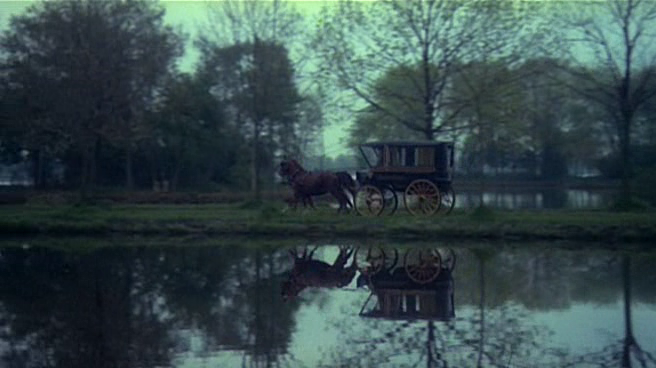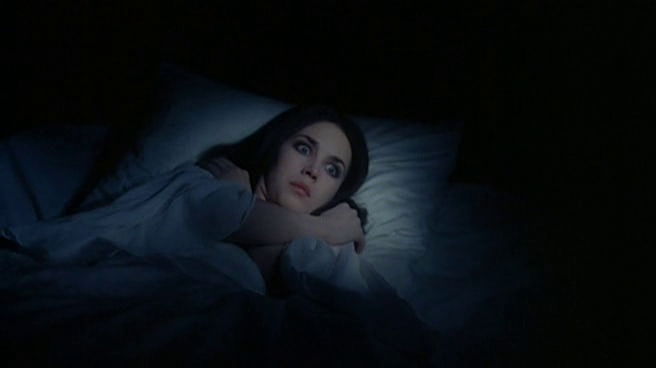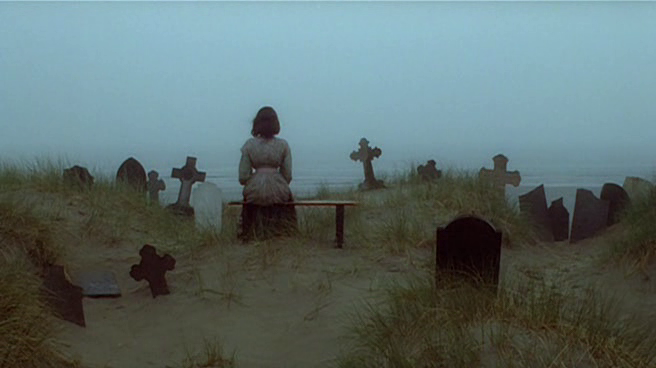“Lucy, my wife, is in danger — I must save her.”
|

Synopsis:
In 19th century Europe, a real estate agent (Bruno Ganz) is sent by his boss (Roland Topor) to secure a sale with Count Dracula (Klaus Kinski) in Transylvania. Dracula quickly becomes enamored from afar with Ganz’s beautiful wife (Isabelle Adjani), and sets sail to ravish her.
|
|
Genres:
- Bruno Ganz Films
- German Films
- Vampires
- Werner Herzog Films
Response to Peary’s Review:
Peary writes that “Werner Herzog’s remake of F.W. Murnau’s horror classic is beautifully filmed but too slow”, and notes that you’ll be “half asleep” by the time Ganz “reaches the castle of Count Dracula”. He writes that “what’s most disappointing is that the themes and storyline are almost identical to Murnau’s still widely circulated film, making one wonder if Herzog undertook the project only to see if he could make Kinski look like Max Schreck’s vampire (he comes mighty close)”. While it’s true that Herzog’s film is an unmistakably direct homage to Murnau’s film — he’s called it the best movie to come out of Germany — Herzog brings a unique vision to the project, making it distinctively his own. Working with cinematographer Jörg Schmidt-Reitwein, he crafts a luminously saturated historical landscape in which mortals interface warily with vampires, and it’s easy to imagine Dracula’s legend taking root. I agree with Peary that the film moves too slowly — patience is required; but Kinski is mesmerizing as the tortured Nosferatu, and the visuals (including impressive sets, costumes, make-up, and hundreds of live rats) are highly memorable.
Redeeming Qualities and Moments:
- Klaus Kinski as Nosferatu

- Jörg Schmidt-Reitwein’s cinematography


- Fine period sets and costumes


- Effectively creepy make-up

- Many memorable scenes and images

- The eclectic and haunting soundtrack by Popul Vuh and others
Must See?
Yes, as a visually evocative homage to a cinematic classic.
Categories
(Listed in 1001 Movies You Must See Before You Die)
Links:
|








3 thoughts on “Nosferatu the Vampyre / Nosferatu der Nacht (1979)”
A once-must, as a unique re-imagining of the familiar Dracula tale – and as one of Herzog’s best films.
It took over 35 years (since its release) for me to revisit this. My remembrance of it was not that clear so I didn’t approach a second viewing with any particular feeling. However, I was surprised by how easily I got caught up in it.
It seems to me that Herzog clues us in right away as to what to prepare ourselves for – by his lingering pan of death figures. It’s like he’s letting us know he intends to take that aspect of the Dracula story very seriously and he has an opinion of it: that an imagined life of the undead is nothing but a grotesque idea.
~even Kinski – as Dracula – basically says that his existence is a horror even to him.
I don’t find the film slow – but I can imagine why some people would. Most audiences are accustomed to a typical Dracula film being faster-paced, as a ‘logical’ rhythm for a story comprised mainly of anticipation and fear.
But what I take away from the film is the understanding that horror is not always quick – it can be slowly methodical and insidious; the cruelty of it can take its time.
In fact, one of my favorite scenes is when the ship Dracula has boarded for the purpose of re-location finally enters its destination port. Dracula is the only one aboard that’s ‘alive’, and the solemn feeling of the inevitable feels palpable.
(I also esp. like the common-sense complexity of the film’s conclusion.)
Another plus for the film: as Lucy, Adjani is pro-active; she’s not merely seen (as Lucy is commonly presented) as a one-dimensional object of beauty and life force. This is a Lucy with real guts.
I’m in complete agreement re: the film’s soundtrack. It is possibly the best one I’ve ever heard for a Herzog film, and it is particularly in-tune with the style and feel of the film throughout.
Side Note: There’s not much that Topor can do with Renfield; that tends to be the case with anyone playing the role – it’s so terminally subservient and how much can one do with a character who mainly giggles maniacally? Nevertheless, I found it interesting to learn that the actor was also a writer (i.e., he wrote the original novel of Polanski’s ‘The Tenant’).
As with most Herzog films, we are rewarded with striking, lingering visuals. The storyline is familiar to the point of being ubiquitous, so style is the focus, and Herzog delivers on that front. I don’t agree that it’s too slow, but then it depends on what you’re comparing it to. If you’re comparing this to the pacing of Val Lewton, it’s a dirge. But then put beside Hans-Jurgen Syderberg, it’s a breeze.
It has a lot in common with Heart of Glass and Aguirre: everyone seems to be in a trance or fog, or off kilter. Great creepy soundtrack. Not a film worthy of rewatching as often as say Aguirre, Enigma of Kaspar Hauser or Fitzcarraldo, but is interesting and worth at least one viewing.
An amazing film, and a rare remake that at the very least equals the original. This version has a mesmerising atmosphere and the score by Florian Fricke and Popul Vuh is a classic in its own right.
A must purley as one of Herzog’s best films.